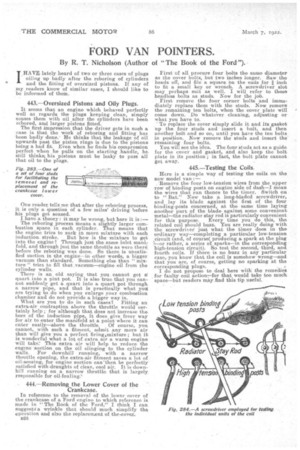FORD VAN POINTERS.
Page 26

If you've noticed an error in this article please click here to report it so we can fix it.
By R. T. Nicholson (Author of "The Book of the Forct").
,HAVE lately heard of two or three cases of plugs oiling up badly after the reboring of cylinders t• and the fitting of oversized pistons. If any of my readers know of similar cases, I should like to be informed of them.
443.—Oversized Pistons and Oily Plugs.
It seems that an engine which behaved perfectly well as regards the plugs keeping clean' simply souses them with oil after the cylinders have been rebored, and larger pistons fitted. The first impression that the driver gets in such a ease is that the work of reboring and fitting has been badly done: Re thinks that the leakage of oil upwards past the piston rings is due to the pistons being a bad fit. Even when he finds his compression perfect when he pulls on the starting handle, he. still thinks; his pistons must be leaky to pass all that oil to the plugs.
Fig. 283.—One of a set of four studs for facilitating Me removal and replacement of the crankcase lower cover.
One reader, tells me that after the reboring process, it is only a queution of a few miles' driving before his plugs get soused.
I have a theory : it may be wrong, but here it is:—
The reboring process means a slightly larger combustion space in each cylinder. That means that the engine tries to suck in more mixture with each induction. stroke. But how is the mixture to get into the engine ? Through just the same inlet inani fold, and through just the same throttle as were there before the reboring was done. So there is unsatisfied suction in the engine—in other words, a bigger vacuum than standard. Something else than " mixture " tries to fill that .vacuum—engine oil from the cylinder walls.
There is an old saying that you cannot get te quart into a pint pot. It is also true that you cannot suddenly get a quart into a quart pot through a narrow pipe, and that is practically what youl are trying to do when you enlarge your combustion chamber and do not provide a bigger way in. What are you to do in such cases? Fitting an extra-air contraption above the throttle would certainly help ; for although that does not increase the bore of the induction pipe, it does give freer way for air to enter the manifold at a point where it can enter easily—above the throttle. Of course, you cannot, with such a fitment, admit any more air than will give you a perfect firing,mixture ; but it is wonderful what a lot of extra air a warm engine will take This extra air will help to reduce the engine suction on the oil clinging to the cylinder walls. For downhill running, with a narrow throttle opening, the extra-air fitment saves a lot of oil-sousing, for engine suction can then be perfectly satisfied with draughts of clean, cool air. It is downhill running on a narrow throttle that is largely, responsible for oil-fouling:.
444.—Removing the Lower Cover of the Crankcase.
In reference to the removal of the lower cover of the crankcase of a Ford engine to which reference is made in "The Book of the Ford," I think I can suggesti a wrinkle that should much simplify the operation and also the replacement of the.eovez. s28 First of all procure four bolts the same diameter as the cover bolts, but two inches longer. Saw the heads off, and file a square bn the ends for I inch to fit a small key or wrench. A screwdriver slot may perhaps suit as well. I will refer to these headless bolts as studs. Now for the job. ' First remove the four corner bolts and immediately replace them with the studs. Now remove the remaining ten bolts, when the cover plate will come down. Do whatever cleaning, adjusting or what you have to. To replace the cover simply slide it and its gasket up the four studs and insert a bolt, and then another bolt and so op, until you have the ten bolts in position. Now remove the studs and insert the remaining four bolts. You will sec the idea. The four sleds act as a guide for the cover and gasket, and also keep the bolt plate in its position ; in fact, the bolt plate cannot get away.
445.—Testing the WIS.
Here is a simple way of testing the coils on the new model van :— . 'Remove the four low-tension wires from the upper row of binding posts on engine side of dash—I mean the wires that run thence to the tinier. Switch on to "Bat." Now take a long-bladed screwdriver, and lay its blade against the first of the four binding-posts concerned, at the same time laying another part of the blade against some convenient metal—the radiator stay rod is particularly convenient
for this purpose. Every time you do this, the related coil should buzz. You are really doing with the screwdriver' just what the timer does in the ordinary way—completing a particular low-tension circuit (and, of course( producing a spark at the plug —or rather, a series of sparks—in the corresponding high-tension circuit). So test the second, third, and fourth coils. If there is no buzz in any particular case, you know' that the coil is somehow wrong—and that you are, of course, getting no sparking at the corresponding plugs. I do not propose to deal here with the remedies for faulty coil action-,--for that would take too much space--but readers my find this tip. useful.






























